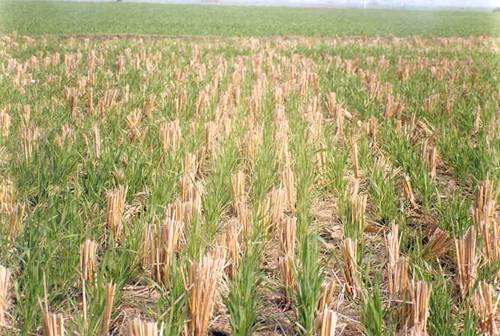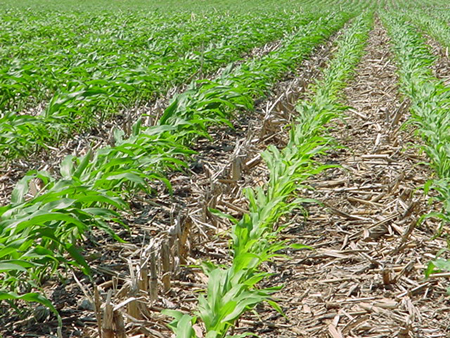
|
|||
| Home | Seasons & Varieties | Tillage | Nutrient Mgmnt | Irrigation Mgmnt | Weed Mgmnt | Crop Protection | Cost of Cultivation | Photobank | |||
Tillage :: Modern Concepts of Tillage |
|||
Modern concepts of Tillage In conventional tillage, energy is often wasted and sometimes, soil structure is destroyed. Recently considerable changes has taken place in tillage practices and several new concepts have been introduced namely, minimum tillage, zero tillage, stubble mulch tillage. The immediate cause for introducing minimum tillage was high cost of tillage due to steep rise in oil prices. In addition there are problems associated with conventional tillage. Repeated use of heavy machinery, destroys structure, causes soil pans and leads to erosion. The needs of planting zone (row zone) and water management zone (inter row zone) are different. In row crops, it is sufficient to provide fine tilth in the row zone for creating conditions optimal for sowing and conducive to rapid and complete germination and seedling establishment. In the inter-row zone, secondary tillage is not done and it should be rough and cloddy where soil structure is coarse and open so that weeds may not germinate and more water infiltrates into the soil. The important object of tillage is weed control which can be done by herbicides. The Practice of inverting the top soil in order to bury manures and crop residues becomes less important object of tillage in modem field management as the use of animal and green manure is rather uncommon. Crop residues can and in many cases should be left over the surface as stubble mulch to protect against evaporation and erosion losses. Research has shown that frequent tillage is rarely beneficial and often detrimental. All these reasons led to the development and practice of minimum tillage, zero tillage and stubble mulch farming etc. Minimum Tillage It involves considerable soil disturbance, though to a much lesser extent than that associated with conventional tillage. Minimum tillage is aimed at reducing tillage to the minimum necessary for ensuring a good seedbed, rapid germination, a satisfactory stand and favourable growing conditions. Tillage can be reduced in two ways:
Advantages of minimum tillage
Note: These advantages are evident on coarse and medium textured soils and appear after two to three years of practicing minimum tillage. Disadvantages of minimum tillage
Different methods of minimum tillage practiced Row Zone Tillage After primary tillage with mould board plough, secondary tillage operations like disking and harrowing are reduced. The secondary tillage is done in the row zone only. Plough-plant Tillage After the soil is ploughed, a special planter is used and in one run over the field, the row zone is' pulverised and seeds are sown. Wheel Track Planting Ploughing is done as usual. Tractor is used for sowing and the wheels of the tractor pulverise the row zone. Zero TillageZero tillage is also called as no till. Zero tillage is an extreme form of minimum tillage. Primary tillage is completely avoided and secondary tillage is restricted to seedbed preparation in the row zone only. Till planting is one method of practicing zero tillage. The machinery accomplishes four task in one operation: clean a narrow strip over the crop row, open the soil for seed insertion, place the seed and cover the seed properly. A wide sweep and trash bars clear a strip over the previous crop row and planter-shoe opens a narrow strip into which seeds are planted and covered. In zero tillage, herbicide functions are extended. Before sowing, the vegetation present has to be destroyed for which broad spectrum, nonselective herbicides with relatively short residual effect (Paraquat, Glyphosate etc.,) are used.
Stubble mulch Tillage Conventional method of tillage results in soil erosion. Stubble mulch tillage or stubble mulch farming a new approach was developed for keeping soil protected at all times whether by growing a crop or by crop residues left on the surface during fallow periods. It is a year round system of managing plant residue with implements that undercut residue, loosen the soil and kill weeds. Sweeps or blades are generally used to cut the soil up to 12 to 15cm depth in the first operation after harvest and the depth of cut reduced during subsequent operations. When unusually large amount of residues are present, a disc type implement is used for the first operation to incorporate some of the residues into the soil. This hastens decomposition, but still keeps enough residues on the soil. Two methods are adopted for sowing crops in stubble mulch farming: 1. Similar to zero tillage, a wide sweep and trash-bars are used to clear a strip and a narrow planter-shoe opens a narrow furrow into which seeds are placed. 2. A narrow chisel of 5 to 10 cm width is worked through the soil at a depth of 15 to 30 cm leaving all plant residues on the surface. The chisel shatters tillage pans and surface crusts. Planting is done through residues with special planters. Photo Source: |
|||
| Home | Seasons & Varieties | Tillage | Nutrient Management | Irrigation Management | Weed Management | Crop Protection | Cost of Cultivation | © All Rights Reserved. TNAU-2016. |
|||

